The COVID-19 pandemic provided a much-needed sanity check for IoT-inspired frameworks and solutions. IoT solutions such as remote health monitoring and contact tracing provided support for authorities to successfully manage the spread of the coronavirus.
- Internet of Things
- COVID-19
- pandemic
- IoT solutions
- IoT privacy and security challenges
- IoT applications
1. Introduction
IoT currently plays an important role in many fields. Healthcare is one of the prominent sectors benefitted by the advancement of IoT [2]. In the health sector, IoT has drastically changed the lives of both the young and elderly, as it can constantly track their health [3]. These devices are of greater use with reduced cost and faster disease diagnosis. The role of the IoT landscape has been significantly changed due to the COVID-19 pandemic [4]. Some use is directly related to mitigating the spread of the virus (e.g., contact tracing, temperature screening, etc.) whereas others seek to facilitate the new normal created by the pandemic (e.g., working from home, homeschooling, home fitness, etc.) [5][6][7].
2. A Framework of Solutions to Tackle COVID-19 and Emerging Pandemics in the Future Using IoT
The implemented health regulations (local and national-wide lockdowns) that ensured the safety of the people had a significant impact on many different industries. This review sought to understand the usage and impact of IoT-based technologies on COVID-19. The selected applications and industry sectors are not an exhaustive list. It is chosen based on the initial research conducted by the authors and based on the recommendations by previous empirical studies. A multitude of applications and industry sectors which used IoT-based technologies during COVID-19 were identified from the initial research.
Table 1 illustrates the top search results that appeared for different keyword combinations. Based on the number of search appearances and recommendations made by previous empirical studies [10][11][12][13], the following industry sectors and applications are chosen for in-depth analysis in the study.
Table 1.
| Database | SCOPUS Library (Journals) | ACM Library | IEEE Xplore | Google Scholar | |||
|---|---|---|---|---|---|---|---|
| Keywords | |||||||
| IoT or Internet of Things and COVID and Health | 561 | 75 | 68 | 11,800 | |||
| 1 | Public Transportation Monitoring [33] | Public Transportation Monitoring [ | IoT or Internet of Things and COVID and Transport | 203 | 39 | 6 | 5460 |
| IoT or Internet of Things and COVID and Education |

Figure 5.
Table 4.
| IoT Application | Societal and Economic Impact (Low, Medium, High) | Timeline for Wide Usage (Immediate, Post-COVID-19, Future) | Technology Readiness Levels (TRLs) of the Application for Wider Deployment |
|---|
[47]. This system does not register personal information and does not provide contact tracing information, thus ensuring people’s privacy.
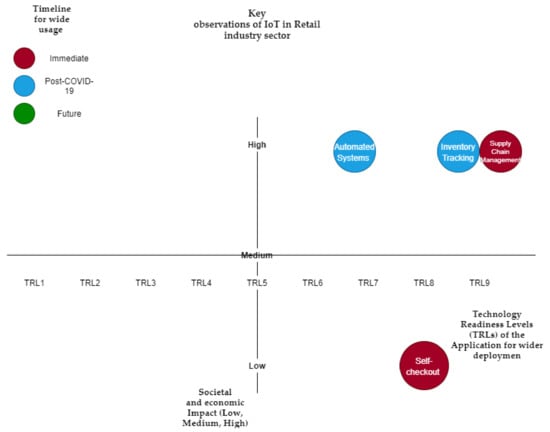
Figure 6.
Table 5.
| IoT Application | Societal and Economic Impact (Low, Medium, High) | Timeline for Wide Usage (Immediate, Post-COVID-19, Future) | Technology Readiness Levels (TRLs) of the Application for Wider Deployment | |||||||
|---|---|---|---|---|---|---|---|---|---|---|
| 45 | ] | High | Immediate | TRL9 | ||||||
| 1 | Distance Learning [39][40] | Distance Learning [51,52] | ||||||||
| 1 | Supply Chain Management [44][ | Medium | 45 | Immediate | TRL6 | ][46] | Supply Chain Management [56,57,58] | High | Immediate | TRL9 |
| 2 | Intelligent Transportation System [32][35] | Intelligent Transportation System [44,47] | ||||||||
| 386 | 62 | 19 | 9110 | |||||||
| IoT or Internet of Things and COVID and Communication | 852 | 87 | 70 | 12,900 | ||||||
| IoT or Internet of Things and COVID and Retail | 21 | 9 | 5 | 3050 | ||||||
| IoT or Internet of Things and COVID and Entertainment | 24 | 7 | 4 | 1870 | ||||||
| IoT or Internet of Things and COVID and Contact tracing | 206 | 77 | 13 | 1860 |
-
Healthcare
-
Transportation
-
Education and communication
-
Retail, entertainment
Furthermore, some sectors were combined to effectively evaluate the usage and impact of the chosen applications. While industry sectors such as healthcare are mentioned in almost all previous studies in the literature, some of the sectors discussed in this article are not widely researched. In addition to the selected sectors, IoT has been used in several other industries, such as agriculture and hospitality [14][15][16]. However, a wider usage has not been observed for those sectors, in comparison to the selected applications for this study.
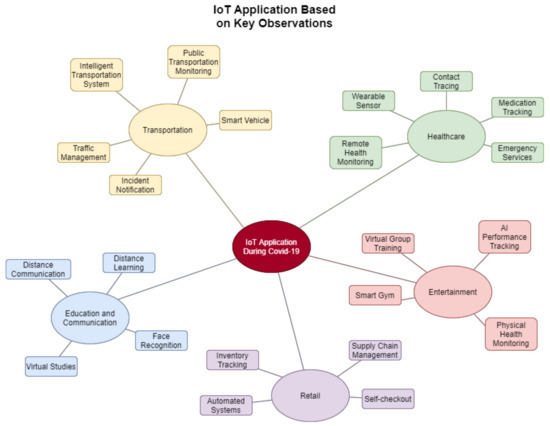
Figure 1.

Figure 2.
2.1. IoT in the healthcare sector
COVID-19 is caused by the SARS-CoV-2 virus, which affects the respiratory system. Research in [17] proposes a wearable strain sensor that measures the volume and respiration rate of the user’s respiratory system. These sensors can track and monitor patients’ breathing conditions through the Internet of Medical Things (IoMT) and continuously update the involved doctors of the patient’s respiratory condition. This is also time saving, as it is easier for the concerned doctors to make appropriate recommendations remotely. The author of [18] proposes a wearable IoT-based system to detect stress levels. This is an appropriate solution for people who are suffering from stress, anxiety, and isolation due to the pandemic.
During the COVID-19 pandemic, the use of contact tracing has proved to be an appropriate solution to protect personal data, while keeping people safe. There are wearable light IoT devices such as Triax Proximity Trace that use contact tracing to address social distancing as it alarms users when they are too close to each other [6]. Enterprise departments can distribute wearable devices that ensure safety regulations without the need for mobile phones or downloads. Tags are sent through Bluetooth technology without the need to track a user’s location. In addition, anonymized keys that change every 15 min are used for further privacy protection. The Province of Alberta has introduced contact tracing application for COVID-19. The application confirms positive cases and notifies Canadians who have been near those who have received a positive result [19].
Stanford Children’s Health Hospital was able to jump from meeting 20 patients daily to more than 600 patients through a two-way, live telehealth interaction, or “virtual visit” [20]. Electronic communications—audio and video—are used to allow interaction between the patients and their consultant or healthcare provider without having to meet in person, which is a viable alternative rather than a mass gathering in the hospital with a chance of virus infection.
Another great solution for home-based health monitoring is the smart thermometer, Kinsa. The device can map fever and illness to help users to react faster with the current situation. It also keeps logs of a family’s health and their health history, tracks medications and set reminders, and offers friendly features for kids’ ease of use. The device connects to the Kinsa App using Bluetooth and extra information can later be sent to the concerned party [21].
During the pandemic, medical staff associated with ambulance services deal with more pressured and tense situations. Ambulance IoT aided equipment provides solutions that are time-efficient, where experts can advise the staff of necessary actions to deal with patients in critical situations [10]. IoT-based Emergency Medical Services (EMS) are great systems to save lives in critical situations. The author of [22] proposes a system that provides real-time information regarding the number of available beds, blood levels of all types, blood type availability, and doctors’ availability. Real-time data can be obtained from the ambulance during major accidents and with multiple casualties.
Table 2.
| IoT Application | Societal and Economic Impact (Low, Medium, High) | Timeline for Wide Usage (Immediate, Post-COVID-19, Future) | Technology Readiness Levels (TRLs) of the Application for Wider Deployment | ||||
|---|---|---|---|---|---|---|---|
| 1 | Remote Health Monitoring [5][[25] | Remote Health Monitoring [5 | 23][24] | ,13,14,16] | High | Immediate | TRL9 |
| Medium | Immediate |
Gupta and Jilla proposed the Digital Fitness Connector (DFC), which is compatible with over 80 ANT health and fitness sensors. The sensors are able to track speed, heart rate, power, cadence, pace, and distance, which is also connected to smartphones [26]. This helps the users to monitor their physical activity in real-time and store their data.
This technology can go along with pandemic or governmental regulations as it helps reduce face-to-face interactions, imposes limits on gathering with other people, and mitigate the risk of exposure to coronavirus at any healthcare premises. These lightweight devices can also help in reinforcing and implementing these regulations. There are a few countries—Jordan, Bahrain, and Bulgaria—that use electronic bracelets as a monitoring and control mechanism to ensure that the public are in line with coronavirus quarantine measures and to ensure that the rules are respected by those who are self-isolating [27][28][29].
A research presented by [50] provides an indoor, cost-effective IoT monitoring system for COVID-19. The system uses Rasberyy Pi, temperature sensors, camera, and Arduino for mask detection, contactless temperature sensing, and to check the social distance between the individuals. Even though the system performance is limited to the kind of hardware used, it provides a decent result. This shows the capability of IoT with the associated technology in smaller spaces.
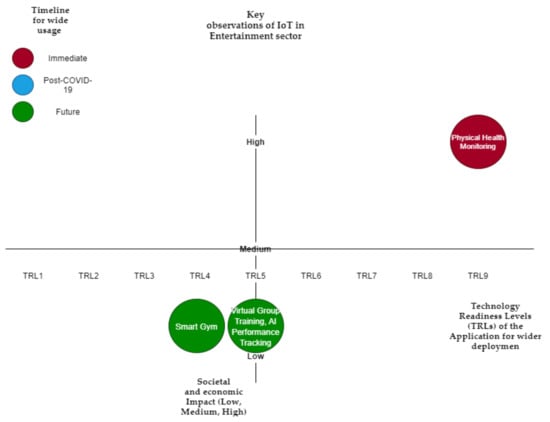
Figure 7.
Table 6.
| IoT Application | Societal and Economic Impact (Low, Medium, High) | Timeline for Wide Usage (Immediate, Post-COVID-19, Future) | Technology Readiness Levels (TRLs) of the Application for Wider Deployment | ||
|---|---|---|---|---|---|
| 2 | Wearable Sensor [5][17][18][26][27][28][29] | Wearable Sensor [5,32,33,38,39,40,41] | High | Immediate | TRL9 |
| 3 | Contact Tracing [6][19] | Contact Tracing [6,34] | High | Immediate | TRL9 |
| 4 | Medication Tracking [9][21] | Medication Tracking [9,36] | High | Post-COVID-19 | TRL8 |
| 5 | Emergency Services [10][22] | Emergency Services [25,37] | High | Immediate | TRL5 |
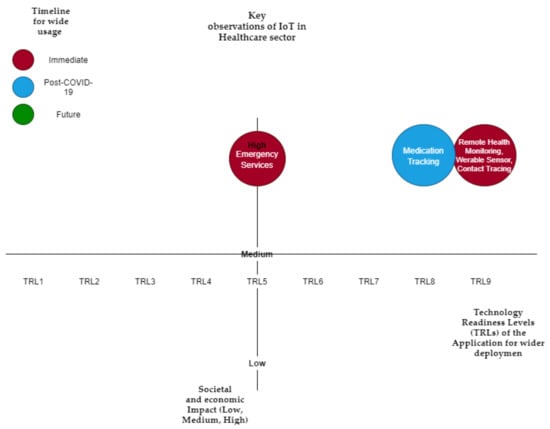
Figure 3.
2.2. IoT in the Transportation Sector
COVID-19 has had a huge impact on the transportation industry. With the adoption of COVID prevention methods, a reduced demand for transport has been noticed [30], which has also affected other areas, such as agricultural supply chains [31]. IoT applications such as the toll and reservation ticketing system, navigation tracking and GIS mapping, control and guidance systems, supply chain management solution systems, and smart vehicle applications can tackle some problems during the pandemic to limit crowded areas and help the process of importing and exporting goods. IoT-based Intelligent transportation systems can provide automation in roadways, railways, marine, and airways [32], which help in limiting human-to-human interaction to reduce the infection risk, while enabling continuation of the workflow.
SALUTARY is a safe and reliable public transportation system that aims to make use of Information and Communication Technologies (ICT) to deal with congested situations in public transportation (bus stops, subway stations, trams, busses, trains, and railway) [33]. The system performs real-time monitoring of the number of users to predict congestion, inform the users, and adapt system operations, such as modifying routes and timetables. Adding the system to the Intelligent Transportation System (ITS) can allow innovative crowd detection and offer services such as online ticketing, reservation, and vehicle access control to limit the congestion.
Sutar proposed an IoT, GPS, and Android-based solution that addresses the issues with traffic management for public transport systems and the increased number of vehicles on the streets [34]. Al-Dweik also proposed an IoT multifunctional real-time roadside unit for intelligent transportation systems that reduce vehicle congestion and mange metering routes [35].
A framework developed by [36] uses real-time datastream and user incident reports to provide incident notification and route recommendation for users who travel mainly by bus.
Vaccine distribution became a key point with the introduction of several reliable vaccines globally. The distribution of vaccines is a critical task due to the temperatures they have to maintain for their effectiveness; for example, Pfizer is required to maintain −700 °C. Many countries have deployed IoT to monitor this cold chain of vaccine deployment. A case reported from Germany had to discard a huge quantity of vaccines since they observed that one supply could not maintain the required temperature throughout the delivery [37]. On the other hand, it was reported that hackers are trying to attack this cold chain of vaccine supply. Therefore, these IoT-based monitoring platforms should be protected from unauthorized access.
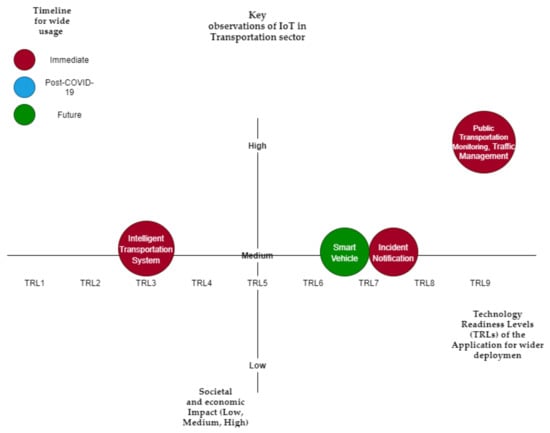
Figure 4.
Table 3.
| IoT Application | Societal and Economic Impact (Low, Medium, High) | Timeline for Wide Usage (Immediate, Post-COVID-19, Future) | Technology Readiness Levels (TRLs) of the Application for Wider Deployment | ||||||||||
|---|---|---|---|---|---|---|---|---|---|---|---|---|---|
| 1 | Virtual Group Training [7] | Low | Future | TRL5 | |||||||||
| TRL3 | |||||||||||||
| 2 | Distance Communication [39] | 2 | [ | Inventory Tracking [44][45] | Inventory Tracking [56 | 40] | Distance Communication [51,52] | High | Immediate | ,57]TRL9 | High | Post-COVID-19 | |
| 2 | Smart Gym [7][49] | Smart Gym [7,61] | Low | TRL9 | |||||||||
| Future | TRL4 | 3 | Smart Vehicle [34] | Smart Vehicle [46] | |||||||||
| 3 | Virtual Studies [39] | Virtual Studies [Medium | 51Future | TRL7 | |||||||||
| ] | Low | Future | TRL5 | 3 | Automated Systems [44] | Automated Systems [56] | High | 4 | Traffic Management [33][34][35] | Traffic Management [45,46,47] | High | Immediate | TRL9 |
| 5 | Incident Notification [36] | Incident Notification [48] | Medium | Immediate | TRL7 |
2.3. IoT in the Education and Communications Sector
The pandemic has forced a change in the education system by limiting face-to-face teaching and on-campus learning [38]. Distance learners and students who study at home will be able to continue their education through IoT and advanced technologies. Studies show that some virtual studies can prepare students for laboratory exercises and essential non-cognitive skills [39].
Ilieva proposed an IoT framework to facilitate adaption of the studying process to the current situation [40]. This framework administers both teaching and examination processes via IoT. The components used are web camera for attendance, behavioural indicators, and emotional state and GPS tracker to capture movement and monitor location; a wearable device that examines brain signals, heart rate, and blood pressure; sensors that examine the collected data and detect abnormalities and notifies the lecturer; and different algorithms such as face recognition, deep learning, and classification algorithms used for monitoring and management. In addition, eye trackers, EEGs, and web cameras are used in examination for student inspection and to detect cheating. The above study shows the real use of IoT to support distance learners.
An integrated IoT framework proposed by Awais focuses on human emotion analysis [41]. The analysis of physiological signals is done through Long Short-Term Memory (LSTM) based emotion recognition to identify different emotions. This framework enables communication and recognition of human emotions in real time of above 95%, which can support student engagement, healthcare infrastructure, and educational institutions in approaching an effective distance learning paradigm while minimising COVID-19 pandemic threats.
Google and Apple recently added a COVID-19 exposure notification system for Android and Apple phones [42]. The system notifies the user when they come into contact with someone who has been reported of having COVID-19. The system also provides instructions of what to do if you have been in contact with someone with COVID-19. The system ensures the user’s privacy by not sharing location and by generating random IDs to prevent tracking. The only information shared is the day of contact, the duration of the contact, and the distance between the users.
2.4. IoT in the Retail Sector
There are different IoT systems that can help with the COVID-19 situation, such as industrial internet of things (IIoT). IoT retail self-checkout and warehouses both reduce human-to-human interactions and eliminate crowded and jammed areas, making it less likely for people to spread or be infected with the virus. With the use of an IoT retail self-checkout, problems such as long queues, billing, and human error can be solved [43] without human intervention. IoT can also be used to enhance supply chain management with delivery, storage, and inventory. An example of this would be the IoT automated systems used in Amazon warehouses, as they provide seamless workflow, real-time tracking, and reduced overall handling costs [44].
Connected products and devices help optimize complex supply chain operations. Inventory tracking can be improved using RFID technology. Smart tags enable real-time product adjustments and pricing [45]. This can limit the number of in-store workers and can enable home workers to easily adjust and monitor the workflow without the need to be physically present, in line with health guidelines. IoT can enhance supply chain performance in quality, cost, flexibility, and delivery with the use of information-sharing, intelligence, data auto capture, and visibility, which improve businesses’ environmental, social, and financial sustainability [46].
A proposed IoT-based Standard Operating Procedure (SOP) compliance system by Bashir that checks the number of people who enter an area and monitors their body temperature, ensures physical distance, and notifies managers and the concerned authorities of any violation
2.5. IoT in the Entertainment Sector
The entertainment industry has been greatly affected by the pandemic. Different activities such as going to the gym, sport fields, clubs, theatres, concerts, and travel are restricted due to the lockdown. The IoT technology can help ease these limitations by providing solutions such as smart gyms and wearable devices. IoT is used in many ways to monitor the physical environment and to collect mobility socio-economic data that save resources and time [48].
JaxJox recently announced an interactive fitness studio, which acts as a smart home gym for users. The system provides different performance data and fitness classes with AI performance tracking and personalized coaching experience. Friends and members can also work out together using the virtual group training function, providing a better experience for group workouts [7]. A framework by Jain provides efficient resource utilization in the gym and provides innovative services to the users [49]. This works as a great solution for users who are not capable of using a public gym anytime soon.
3. The Role of IoT in the Post-COVID-19 Era
IoT has rapidly become one of the most familiar expressions across business and technology, as 20 billion devices and internet connected things were expected in 2020 [51] and the technology global market is expected to grow to around 1.6 trillion dollars in market revenue [52]. Integration of IoT with different technologies such as cloud computing and embedding actuators and smart sensors facilitate interactions with smart things, allowing ease of access in different locations, enhancing data exchange efficiency, and improving storage and computing power [53].
 Encyclopedia
Encyclopedia
